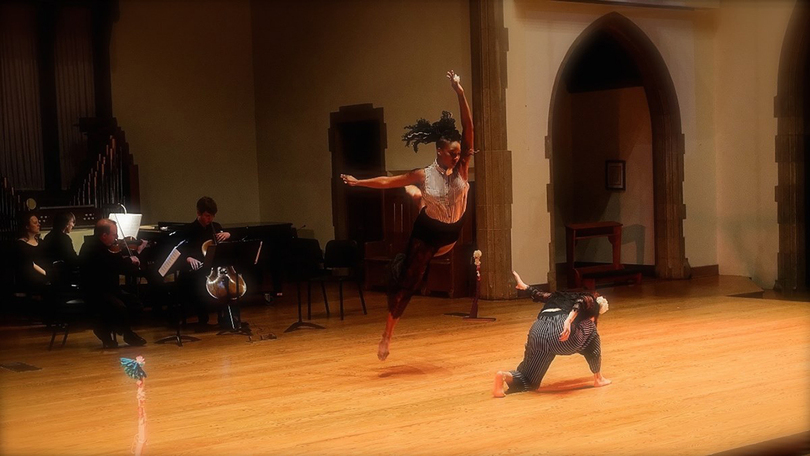Vision of Sound to unite composers, dancers in annual performance

Courtesy of Octavio Vazquez
The annual Vision of Sound will feature live music and dance performances from Western New York-based artists, including Erika Ruegemer and Octavio Vazquez, among others.
Eleven years ago, composer Mark Olivieri had an idea for an event that would bring together the western New York artistic community. He wanted to create a space for those who enjoy seeing the product of hard work and collaboration.
His concept lead to Vision of Sound, a show presented by the Society for New Music, that showcases an artistic fusion of live music and dance. This year’s performance will take place on Sunday at 3 p.m. at The Oncenter’s Carrier Theater.
Vision of Sound will showcase the creativity of various composers, choreographers, musicians and dancers — from the shores of Lake Erie to the Adirondacks — who have collaborated to put together a series of original works.
What makes the show special, choreographer Lynea D’Aprix of the Ballet & Dance of Upstate NY and Camillus Dance Centre said, is that the performances are just as much of a surprise to the musicians and dancers as it will be for its audiences.
“We don’t really ever know exactly how it’s going to be played, and they don’t know exactly how we’re going to dance,” D’Aprix said, “so we just have that moment of connection on the stage for the audience to witness and then that’s it.”
Each piece included in the program varies in length and meaning. Olivieri said he and his wife, Alaina, always try to put together a group of eclectic choreographers and composers so there is no chance of seeing the same piece again.
Once the choreographers and composers are chosen, the choreographers receive a recording of a specific composer’s musical composition. From there, they build a connection to the sound by listening to it many times before translating their interpretations of the music into a series of dance moves.
Erika Ruegemer of the Rochester Dance Theater said she gives the music time to settle into her blood and tell her what to do rather than “make up movements.” She is choreographing Olivieri’s piece “Soulless Chastity,” a 15-minute piano solo performed by Oswego pianist Rob Auler.
Ruegemer interpreted it as a piece about human connection and how easy it is to isolate ourselves from one another. She conveys this through the movements of four dancers in three different parts.
The work begins with all four dancers picking and grabbing at each other as they dance to a steady, upbeat rhythm. It then shifts to the second movement, where the music becomes slower and less layered and the dance turns into a solo that Ruegemer will be dancing.
“That movement is going to show this idea of when you’re alone and you like being alone, but then you’ve been alone too long and you need to get out into the world and have those connections,” she said.
The third movement brings back all four dancers and then ends with Ruegemer alone once again, but this time she moves with freedom and a sense of contentment knowing she has established those connections with others.
Like “Soulless Chastity,” many of the pieces featured at the show explore various aspects of the human experience, including Natalie Draper’s “Shifting Landscapes.”
Draper, an assistant professor at Syracuse University, said that her piece was heavily inspired by her interest in musical transitions, so she has involved a number of shifts in rhythm in it. The piece as a whole works to depict the experience of sitting in a train and looking out the window, watching as the landscape changes over time.
“In the beginning of the piece, there’s a really angular, rhythmic kind of harsh sounding music that just jump cuts like in a film to this very smooth, dream-like music and then jump cuts back to the angular music,” Draper said.
Many of the composers have not actually seen the choreographies to their music and the dancers won’t have practiced with the live music until the actual show. Performers added there will be a real element of surprise as audiences watch the dancers react to the live musicians onstage — something that doesn’t happen when dancing to a recording.
Octavio Vazquez, whose piece entitled “MusicScapes” will be performed in collaboration with choreographer Mariko Yamada, said that something magical happens when the two art forms of dance and music come together onstage.
“Everything is very much alive,” Vazquez said. “It’s very much happening, and there’s an excitement and energy that would be missing if we would be using a recording.”




